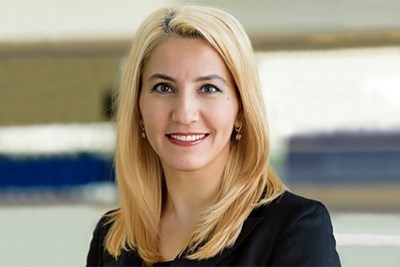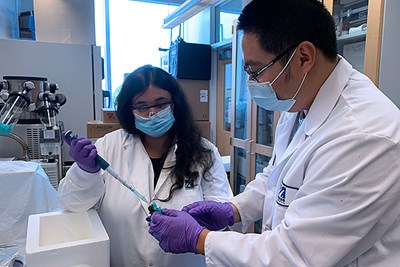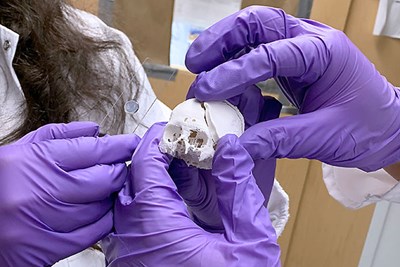NIH awards $2M for UMass Lowell faculty research on bone tissue engineering
Five-year project will develop new biomaterials for repairing and regenerating bone

The National Institutes of Health (NIH) has awarded Chemical Engineering Asst. Prof. Gulden Camci-Unal a five-year grant worth nearly $2 million to support her research on repairing and regenerating bone.
Camci-Unal says currently available methods for bone repair are restricted by the limited availability of bone donors, the potential rejection of the grafted tissue by the patient’s immune system, and the high cost of surgeries.
“Every year, more than 3 million people in the U.S. suffer from bone injuries to the head and face due to trauma, congenital abnormalities, aging and the removal of tumors,” says Camci-Unal, who is the project’s principal investigator.
“While these injuries can be addressed by using the patient’s own bone tissues that are grafted from another part of the body, typically patients become more susceptible to infections as well as suffer further trauma due to the additional surgery needed to harvest the graft,” she says.

The goal of the new research project is to design and synthesize novel composite biomaterials – gelatin-based hydrogels – to create tiny 3D scaffolds or structures where bone cells, called osteoblasts, can grow in the lab and produce a matrix that gets deposited with minerals to form bone. The scaffolds would then be implanted in a patient to repair bone defects or injuries.
According to Camci-Unal, the hydrogel scaffolds that she and her research team are developing are porous and breathable, and they will stimulate vascularization (formation of new blood vessels) and mineralization of the bone tissue to promote regeneration and healing, while strengthening the bone matrix.
“In contrast, traditional synthetic bone grafts usually lack the capability to mimic the properties of vascularized bone or to readily induce bone mineralization,” she notes.
The team’s scaffolds are biodegradable and bioactive, with enough porosity, oxygen content and mechanical strength for repairing bone.
“The scaffolds are easy to handle and are inexpensive,” she says. “They are also biocompatible, which means they will not be rejected by the body’s immune system.”
Camci-Unal says they can use gelatin from different sources – fish, cattle and pigs.
“It is very similar to ordinary gelatin, like the one used to make Jell-O dessert,” she says.

“Our scaffolds are not limited to repairing bones of the head and face. They can be applied to other bone tissues as well, such as cartilage in the joints, spine, ears and nose.”
Members of the research team include biomedical engineering and biotechnology Ph.D. students Sanika Suvarnapathaki and Xinchen Wu, and Prof. Qisheng Tu, a collaborator from the Tufts University School of Dental Medicine.
Designing novel biomaterials is already a field of expertise for Camci-Unal, whose research at UMass Lowell includes work on using common materials like plain, origami-folded paper and pulverized eggshells to construct 3D scaffolds for growing new cells and blood vessels that can help restore, replace or repair damaged tissues or organs.
“They can offer a solution to the acute global shortage of donors for tissue and organ transplants,” says Camci-Unal, who worked at MIT, Harvard University and Harvard Medical School before joining UMass Lowell in 2016.
“Our ultimate goal is to improve human health and the quality of life,” she says.